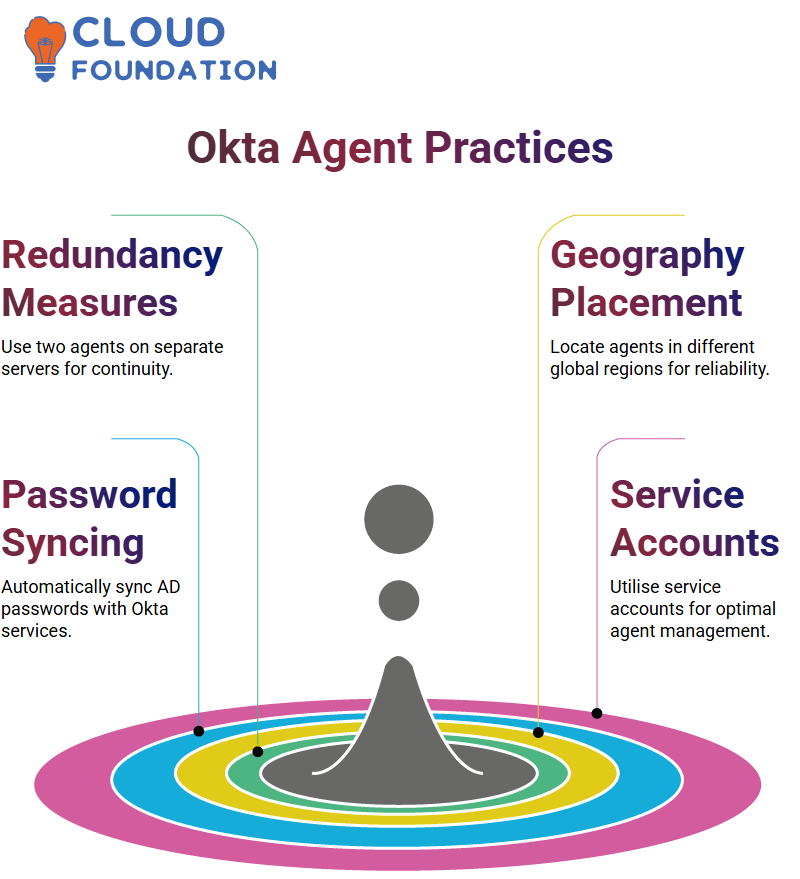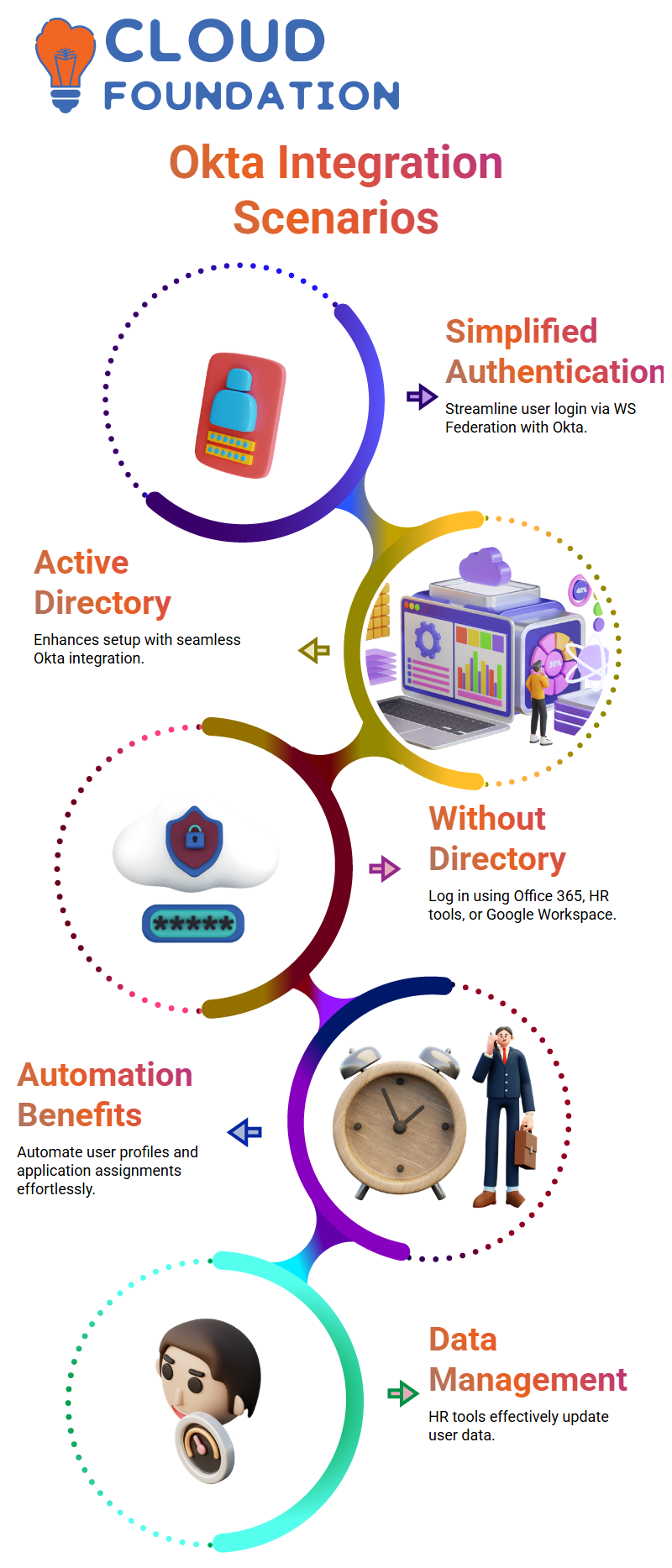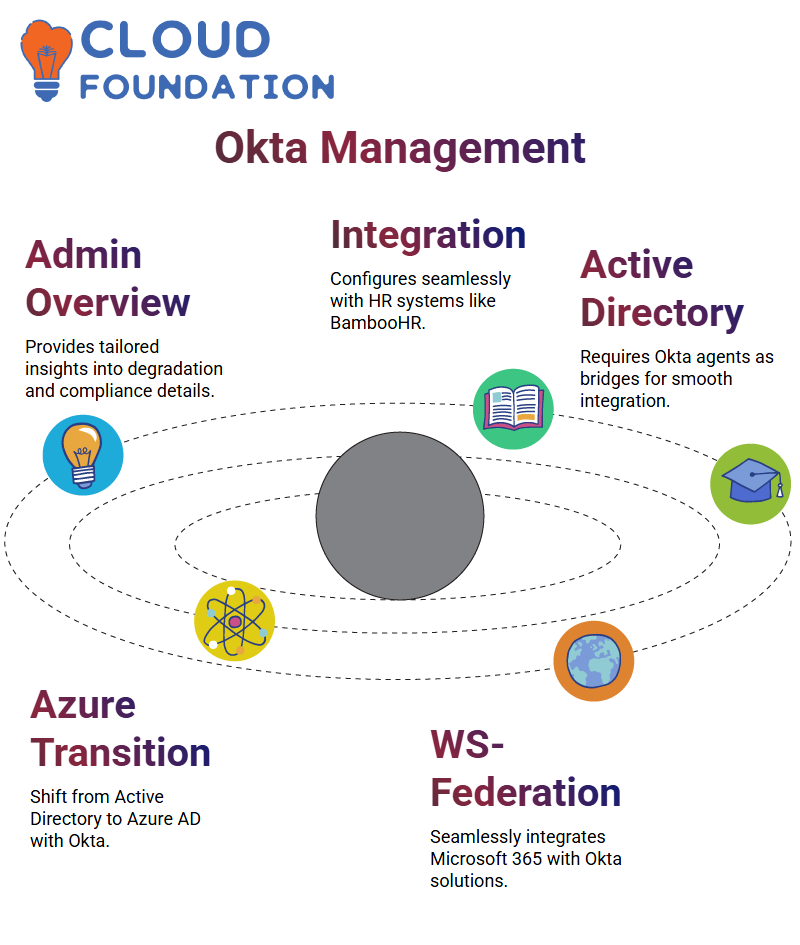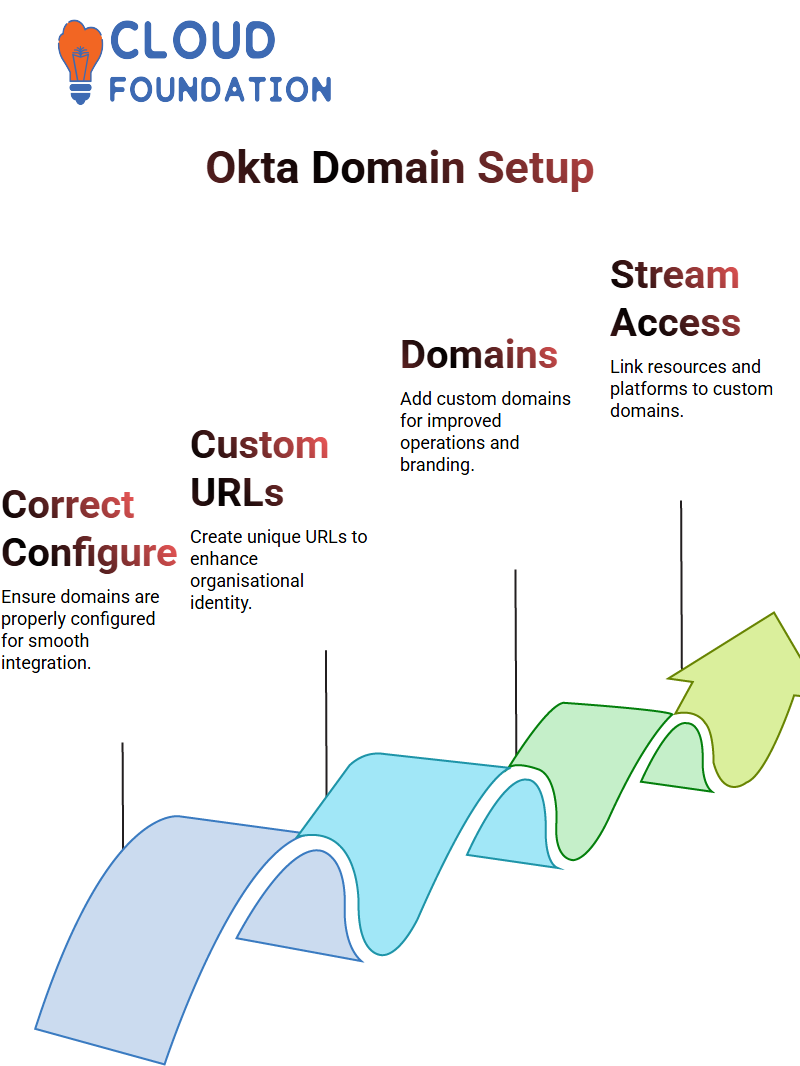Okta Capabilities
Understanding Okta Password Policies
Let me walk you through Okta’s password policies. When managing Active Director with Okta, aligning their policies is paramount – including minimum length requirements, complexity requirements and other key settings that must match.
Setting Up Okta’s Active Directory Integration
Okta makes setting up Active Directory integration effortless. By adding policies to Active Directory, changes are automatically reflected – yet customisation options allow further refinements if required – an outstanding feature! This one really can make all the difference.

Understanding Okta’s AD Agent Manager
When accessing any server, this tool provides essential details about each agent—its name, operational status, and account used; registration domains or proxy servers are easy as well. On its dashboard, the status “agent operational ” is visible. Clicking any particular agent reveals its details, such as name, connection details, and version.
Best Practices for Managing Okta AD Agents
As part of an Active Directory’s redundancy measures, it’s recommended to have at least two AD agents. These should reside on separate servers within the directory but in different geographical regions one may reside in America while the other in Europe or South America, for instance this guarantees continuity if one server goes offline.
Configuring Okta Password Policies and Syncing
Okta makes creating password policies straightforward with its AD password sync feature that automatically syncs user passwords from a domain controller to Okta services. Delegated authentication relies on users providing AD credentials for Okta authentication. With password sync, users could still log into their Okta accounts using those credentials that logged them into AD accounts if anything happened to their domain controller account.

Managing Okta AD Agents Effectively
Always utilise a service account when installing Okta AD agents to ensure optimal operation and seamless management. Personal accounts pose potential threats if their account holders leave or become deactivated, so using one with super admin privileges for better service management If an Okta AD agent becomes problematic, deleting its API token before reinstalling is crucial to solving any associated problems. The system automatically deactivates unhealthy agents upon de-installation, making reinstallation effortless and manageable through its dashboard. Any installed agents will also appear here for viewing purposes.
Automatic Updates for Okta AD Agents
Before, updating Okta AD agents was a time-consuming manual task that required much effort and administrative effort. Okta has introduced a feature (in beta) that automates these updates for you, saving both time and administrative effort by streamlining updates directly onto the AD agents themselves. Once activated, all your AD agents receive automatic updates, reducing administrative overhead costs significantly.
Accessing Okta Downloads
All Okta resources related to downloads are at your fingertips—AD agents included! Connected agents will also be listed here so that you remain highly visible over your setup. Managing downloads and updates has never been simpler with Okta’s user-friendly interface!
Keeping Okta Agents Up-to-Date
Maintaining current Okta agents is paramount; failing to do so will result in a prompt to do so, whether it’s RADIUS server agents, MFA agents for on-premise setups, or MFA for ADFS setups. Staying current is vital—these agents form the backbone of an efficient Okta authentication process, so always stay ahead of updates!
Understanding Okta’s Authentication and Configuration
If someone uses Okta’s on-premises setup with multiple clashing authenticators, you might need to periodically provide specific files that enable seamless authentication in these environments. Furthermore, LDAP allows administrators greater control than Active Directory when configuring specific setups compared with traditional server options (AD).

Okta Browser Plugins and Password less Authentication
Okta browser plugins can be shared among your deployment team for mass deployments. They extend browser functionality while seamlessly integrating into Okta’s ecosystem. Particularly impressive is Okta Verify for password-less authentication, which is available both on the Play Store and ios Store to provide secure yet seamless access for customers.
Device Trust and Okta’s Expanding Compatibility
Okta’s device trust recognises only Mac and Windows platforms; Linux support hasn’t yet been implemented. But Okta is looking at Chrome OS as a potential platform; these increasingly affordable yet feature-packed devices could become widespread within months! Stay tuned – Okta might soon offer full Chrome OS support!
Exploring Okta Workflows
Okta Workflows represents the future of automation within identity environments. Although unavailable across all tenants, workflows offer a no-code platform enabling seamless automation processes. If you have access to one with workflows enabled, take this as an opportunity to experiment and familiarise yourself with this innovative feature.
Preparing for Okta Exams
Understanding features such as workflows and tours is vital to passing an Okta exam, since connecting two Okta environments through all tours is often a question asked in exams. By practising these aspects before taking certification tests, your skills and confidence levels may improve significantly.

Understanding Device Assurance with Okta
When logging in each day, note any new messages from Okta that might pop up; for instance, if anything affects all databases it alerts you so you can take appropriate actions if required—follow the links provided and identify whether addressing it may be required.
Check your Status Site at the bottom. Okta’s tools make it simple to monitor system health: start time, latest updates and any affected areas are easily viewable for quick identification of problems if necessary, leaving no surprises behind!
Using Federation Features in Okta
One of Okta’s standout features, Federation, can make a tremendous difference for organisations utilising Office 365. Knowing how Okta integrates can also make a huge difference for business success. Federation provides seamless authentication; imagine no longer needing to remember multiple passwords!
Today, while exploring Okta, I came across an issue related to Office 365 Federation. The updates here provide start times and affected locations—invaluable details if you manage Office 365! These updates make solving issues straightforward and stress-free.
Secure Authentication with Okta’s Configuration Options
Okta offers reliable web authentication options with strong password management for usernames, passwords and admin setups – such as randomising user passwords to keep things under tight control and safeguarded. For instance, an administrator could set random user passwords, ensuring maximum power and protection.
When configuring Okta options, use secure methods like administrator-controlled options instead of insecure methods like simple bookmarks to maintain strong security without hassles or inconvenience.
Configuring Okta with Office 365
Integrating Okta with Office 365 is simple if you use PowerShell or LDAP. Both methods offer simple authentication options, such as username and password credentials, for authentication through Okta Azure. Once set up, Okta ensures all Windows authentication goes through Azure.
This setup can be invaluable when your organisation does not possess an Active Directory. Pairing Okta with Office 365 makes the authentication process smooth and safe without additional complications or hassle.
Understanding Okta Integration Scenarios
Let me demonstrate how laptops can be managed seamlessly using tools like Intune and Azure AD. In one scenario, users would log into Windows using Azure AD credentials. However, to streamline user authentication more seamlessly and ensure a smooth login experience, WS Federation with Okta can provide users with an alternative path, allowing users to log on using Okta passwords instead. Adding this configuration simplifies the user login experience significantly!
Setting up allows users to log into Okta using their Okta password. Setting it up properly is crucial; otherwise, it becomes redundant and serves no purpose at all. Active Directory environments make this easier;
Setting Up Okta Without Active Directory
With Office 365 and Okta enabled, Windows users can log in via WS Federation; otherwise, your organisation could use an HR tool or Google Workspace instead. However, an HR tool tends to update user data more effectively.

Using Okta with Automation
Automation can make setting up Okta much smoother. For instance, consider an employee joining your organisation through HR; their information then flows automatically into Okta to create their user profile, assign applications based on groups and attributes automatically assigned, and prepare the employee. This streamlines processes while adding tremendous value to any organisation.
Managing Okta and Compliance
Signing on as an administrator gives you an overview tailored to your organisation, with details regarding service degradation and compliance-related information. Okta offers proactive vulnerability remediation while simultaneously meeting regulatory compliance, making it an exceptional solution for identity management.
Understanding Okta’s Direct Integration
Take a deeper dive into Okta’s direct integration. When clients or users require direct integration, configuring it seamlessly should not be an issue, for applications like HR systems like BambooHR, as sources of truth, it should not take long at all to configure here. Most customers relying on Active Directory may find setting it up much simpler. Okta health documentation provides an invaluable reference point here!

I don’t have any on-prem objects, but setting them up shouldn’t be too complex. You will require at least two servers with Okta agents installed – these act as bridges between Active Directory data and Okta for processing/organising, and profile creation purposes.
The Shift from Active Directory to Azure AD with Okta
Microsoft Active Directory has become outdated over time, and they are gradually transitioning their users to Azure Active Directory instead. If you use Microsoft 365, Okta offers seamless WS-Federation integration , which ensures seamless functionality for WS-Federation-integrated solutions such as Okta.
Using LDAP and LDAP Interface in Okta
Okta offers another approach in LDAP that may not be widely utilised. Installing and configuring its agent follows a similar setup procedure. However, its unique LDAP interface enables external applications like Jamf to easily retrieve information from Okta via their interface, which is particularly useful when targeting systems that require data inputs.
Your configurations can also be edited, including adding or merging Okta groups with others. While flexible enough, most data remains read-only so target systems can easily configure their integrations themselves.
Simplifying Profile Sources in Okta
Okta allows users to connect multiple profile sources, like Workday and BambooHR, which may become complex when managing them simultaneously. My advice for best results and maximum efficiency, focus on one source as your single point of truth to simplify workflows and avoid potential headaches.
Once configured, profile sources appear in Okta’s profile editor for easy reference and editing. Prioritised sources can then be prioritised based on individual preference, ensuring Okta can accommodate its features to meet individual needs without becoming overcomplicated.
Leveraging Self-Service Registration in Okta
Okta’s self-service registration feature enables users to sign up independently, with configurable fields and activation criteria that you set yourself. Workforce accounts should avoid activating this option, as it could allow unauthorised access. For Workday or BambooHR integration purposes, their profiles automatically appear as sources in Okta, enhancing integration capabilities even further.
Exploring Okta Attributes and Customisations
By default, Okta offers standard attributes like first and last names, title, address, preferred language, and time zone that usually cover most situations. However, there may be instances in which something unique or specific needs to be added or changed.
Assume you need an attribute called ‘team,’ but none exists by default. In such an instance, create your custom attribute called “Team,” add its description, and even set it as a unique identifier if desired. Configure its length between 15 and four characters so it does not become required during the user creation process – this allows them to remain optional when not necessary.

Profile Mapping in Okta
Okta offers profile mapping as one of its many convenient features, allowing users to control the data sent to applications. For instance, Okta can send information like user titles or regions directly into specific apps, enabling you to configure these mappings and set how information flows; you can even pass formatted titles directly. Ultimately, profile mapping ensures all user details align properly across apps.
Managing Okta Releases and Preview Features
Okta provides monthly feature releases, beginning with previews to test for bugs or instabilities and provide feedback before going live in production. Testing in preview or sandbox tenants before making changes in production can prevent disruptions that would require further work; investing the time to test now could save hours later
Okta Domain Configurations
While often overlooked, configuring domains correctly ensures smooth integration and functioning within your Okta environment, whether setting it up from scratch or making adjustments. So be mindful when making any adjustments and double-check your settings regularly to prevent disruptions!
Custom URLS with Okta
Building custom URLS is easy for everyone—anyone can do it. But for users, Okta makes this process as smooth as possible: just visit octa.pps.equal.com, and you could win a $25 Netflix voucher! So get creating custom URLS wherever it matters most today!

Wherever your organisation may operate, having at least one custom domain linked to Okta is absolutely vital for effective operation and professionalism. By default, Okta will appear as the company. okta.com; convince them otherwise—make it unique and memorable, such as Okta. company.com? Adding one will add professional finesse while streamlining operations even further within Okta!
The Importance of Okta Custom Domains
Okta lets you personalise domains for maximum organisational benefit, strengthening its online identity. From user management and platform access to linking resources, everything feels tailored specifically towards your company brand using custom domains by Okta. It is always worth taking the extra steps necessary to make such changes! Trust me; making these modifications can have lasting rewards!

Navya Chandrika
Author



